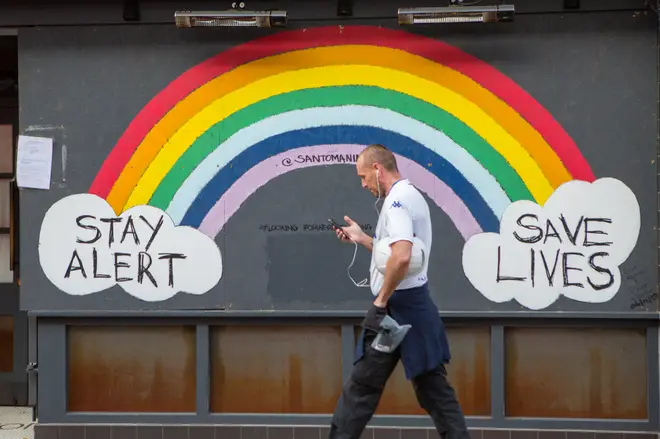
Paul Brand 3pm - 6pm
27 November 2020, 13:42 | Updated: 27 November 2020, 13:56

The UK's R rate has fallen to between 0.9 and 1, SAGE has confirmed.
The R number is also known as the Covid reproduction number and represents the average number of people each Covid positive person goes on to infect.
Scientists have now estimated that the number is edging below one.
The growth rate estimate for the UK is between -2% and 0%, meaning the number of new infections is shrinking by between 0% and 2% every day.
It was between 1.0 and 1.1 last week.
Read more: PM defends Covid tier system as he faces backbench revolt
Read more: New tier system labelled 'unfair' as two thirds of England faces tougher rules

James O'Brien challenges furious caller who believes the Govt is lying
It comes amid the news that excess winter deaths rose by nearly 20% in 2019-20 compared with the previous winter.
The Office for National Statistics (ONS) said there were an estimated 28,300 excess winter deaths in England and Wales in the winter of 2019-20.
This was 19.6% higher than the 23,670 in the winter of 2018-19 but still lower than the 49,410 recorded in the winter of 2017-18.
Excess winter deaths compares the number of deaths during the months of December to March with the average number of deaths in the preceding August to November and the following April to July.
The charity National Energy Action said around 8,500 of the winter deaths in 2019-20 were due to cold homes, and it warned the coming winter could be even worse due to the impact of coronavirus.
Read more: Robert Jenrick explains to LBC why the whole of Kent was placed into Tier 3
Read more: Government asks regulator to assess Oxford/AstraZeneca Covid-19 vaccine

Older caller plans to break Christmas Covid rules
Its chief executive Adam Scorer said: "In our last 'normal' winter, 8,500 lives were lost because of cold homes.
"Low incomes, high energy costs and poor heating and insulation all combined to leave them in conditions which were unfit to help them survive the cold weather.
"This winter that lethal cocktail will be made many times worse by the impact of Covid-19.
"Millions of households on low incomes will be spending more time at home with an impossible decision to make.
"Will they keep themselves and their families warm and probably fall into debt, or will they ration their heating and resign themselves to life in a dangerously cold home at greater risk of the very health conditions that follow Covid-19?"
The charity called for three measures to help people in fuel poverty this winter, including "maintaining and strengthening" the Universal Credit uplift, halting enforcement action and finding new ways to help people in debt.
For the winter of 2019-20, the ONS said it had excluded deaths where coronavirus was mentioned on the death certificate from the main figures in order to improve the "comparability of this winter's measure with previous years".
When Covid-19 deaths were included there were an estimated 8,700 excess winter deaths during the 2019-20 season - the lowest number recorded since the data time series began in 1950-51.
However, the ONS said: "The low estimate is explained by the comparison with the large number of Covid-19 deaths that occurred mainly in the non-winter months April to July, rather than an exceptionally low number of winter deaths."

Sadiq Khan urges Londoners to show "no complacency" under Tier 2 restrictions
The new data, published on Friday, also showed that respiratory diseases continued to be the leading cause of excess winter deaths that occurred in 2019-20.
Respiratory diseases accounted for 39.6% of all excess winter deaths in England and 40.0% in Wales, the ONS added.
In England there were an estimated 26,500 excess winter deaths in 2019-20, with 50.2% among males and 49.4% among females, the ONS said.
In Wales there were an estimated 2,000 excess winter deaths in 2019-20, which was split evenly between males and females.
Wales had the highest percentage of extra deaths in the winter of 2019-20 at 19.2%, followed by the North West at 19.0% and London at 18.6%.
The excess deaths mortality index for these areas was "statistically significantly" higher than the England average of 16.8%, the ONS said.
In comparison, Yorkshire and the Humber at 15.7%, the East of England at 15.6%, the South West at 15.2% and the North East at 13.8% were statistically significantly lower, it added.
The excess winter mortality index is calculated so that comparisons can be made between sexes, age groups and regions, and shows the percentage of extra deaths that occurred between December and March.